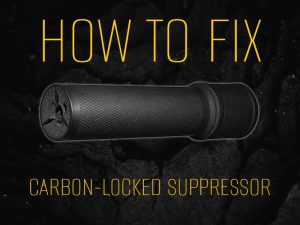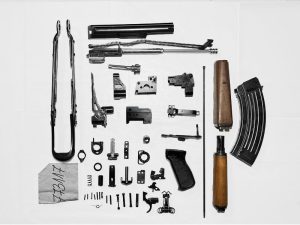You bought a 3D-printed titanium suppressor. It’s a space-age can. Treat it like one.
Titanium forgives heat and abuse better than most metals, and modern 3D-printed geometries shrug off a lot of crud. Still, fouling creeps in, mounts seize, and bad chemistry can bite. Here’s a straight-shooting care guide that respects what actual manufacturers say — not shop folklore.
First principles: what to expect
Titanium rifle cans usually don’t need frequent tear-downs.
They are built as sealed units, and you need to maintain the mount and do occasional solvent soaks instead.
For example, centerfire rifle silencers don’t need the same routine as rimfire or pistol units, and we recommend nylon/brass tools and solvent soaks if you want to freshen things up.
Flow-through, fully 3D-printed titanium models usually have practical service intervals: clean about every 2,500–3,000 rounds for their rifle cans, and use CLP soaks or an ultrasonic cleaner; expect a little extra debris to blow out on the first shots after a soak.
Rimfire through titanium? Lead builds fast. That calls for a much tighter interval: clean about every 500 rounds or when the can gains noticeable weight.
Weigh a new can and plan a cleaning when carbon adds roughly an ounce — a simple, objective trigger that prevents hardened layers.
The don’ts: avoid these common mistakes
- Don’t mix “the dip.” Vinegar plus hydrogen peroxide creates peracetic acid that dissolves lead into water-soluble lead acetate. That brew brings serious toxicity and disposal headaches. Industry sources say to skip it outright. Use safer commercial solvents instead.
- Don’t attack titanium with steel tools. Steel scrapers and aggressive picks can mar surfaces and gall threads. Use nylon or brass brushes or Scotch-Brite with solvent.
- Don’t chase every speck. Rifle cans tolerate a lot of carbon without any loss that you can hear or see. If you watch weight or follow the round-count guidance above, you’ll stay ahead of performance loss without over-servicing.
- Don’t crank chemicals at random. Ultrasonic baths, soda blasters, or acidic cleaners may work in some contexts, but what matters is your model’s manual. For titanium models, ultrasonic is fine; for others, a 24-hour CLP soak and drain does the job. When in doubt, follow the book.
- Don’t panic if it sticks. If a module or cap refuses to budge, use soft jaws in a vise and a strap wrench. Tighten only enough to hold the part, then break it loose. No torch, no cheater bar.
A fast, field-tested cleaning routine
- Make safe, then cool. Clear the firearm, remove the mag, check the chamber, and give the can a minute if it feels hot. Heat is a real hazard; treat it with respect.
- Strip the easy stuff. Pull the can. Wipe the exterior. Brush the mount threads, tapers, and shoulders with CLP and a nylon or brass brush. No steel.
- Soak if needed. For a sealed 3D-printed Ti can, cap the muzzle end with a finger over a rag, pour in a bit of CLP or a suppressor-safe solvent, rotate to wet internals, then stand it muzzle-down to drain on shop towels.
- Optionally run ultrasonic — model permitting. Drop parts per your manual (mount hardware, pistons, etc.). For FLOW Ti cans, ultrasonic is allowed; for others, stick to soaks. Rinse and dry fully. Expect some leftover liquid to exit on the first shots.
- Re-lube smartly. Add a light touch of high-temp anti-seize to threaded mount parts (not the actual taper faces unless your brand says so). Reassemble per spec. Griffin’s manual confirms this helps future removal.
- Confirm alignment. Use an alignment rod before live fire. Then shoot a few rounds in a safe direction; ignore a tiny puff of solvent mist. The manuals say that can happen.
Special cases: pistol and rimfire titanium
Pistol Ti cans with boosters need a little extra love. Do a light coat of high-temp grease on the piston, spring, and O-ring before each session and a maintenance cycle around every 1,000 rounds on those assemblies. Clean the solid Ti body as above.
Rimfire through titanium piles lead fast. Follow the short interval and weight check, and never resort to homebrew “dip” chemistry.
Storage and transport tips
- Store dry. Solvent left inside can spit or stain. Manuals warn about residual solvent expelling on the next range trip — plan for that and keep the bore line clear.
- Cap threads. A simple thread protector keeps grit out and prevents galling when you mount up again.
- Keep anti-seize in the range bag. A pea-size dab saves a seized hub after a long, hot day. Griffin’s note on high-temp anti-seize isn’t a gimmick — it works.
Bottom line
Follow the book, not the myths. Keep interfaces clean, use the right lube in the right place, soak instead of scraping, and reserve ultrasonic for models that allow it.
Skip dangerous chemistry like “the dip.” Your 3D-printed titanium suppressor will keep its manners, your mounts will release without a fistfight, and you’ll shoot more and wrench less.



